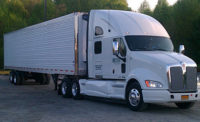Consumer demands continue to shift, e-commerce is expanding, distribution flows are disrupted and there is an increased demand for chilled and frozen foods tailored to personal tastes. These conditions have taxed supply chains, and providers are looking to employ Industry 4.0 to meet these challenges.
For companies with supply chain service offerings, like those in the cold chain industry, this next industrial revolution wave will evolve the way supply chains work, making them anticipatory to demand and helping organizations become more flexible, more accurate, faster and more nimble.
The Internet of Things (IoT) is beyond what the industry has seen during the first three industrial revolutions, which brought about new manufacturing power, mass production and electronic automation.
The first industrial revolution mechanized a number of industries by using water and steam power, followed by the use of electricity during Industry 2.0, further driving the efficiencies of mass production and assembly lines. And, then there was the advent of computers that ushered in Industry 3.0. This was the genesis of automation—when robots and machines began to streamline processes to increase production and replace human workers on assembly lines.
Industry 4.0 doesn’t differ in that it too is taking what was started before it to enhance operations. However, what makes Industry 4.0 different from previous industrial revolutions is the use of smart and autonomous systems—the emergence of data technology trends combined and fueled by data and machine learning that created a gateway for exponential growth in productivity and increased automation in a hyper-connected, data-driven environment.
Over the past few decades, logistics has undergone tremendous transformation. But, there are still many opportunities. As consumer demands and manufacturing shifts continue, the cold chain will also be able to embrace and benefit from the fourth revolution. The trick is to predict the extent and its direction by welcoming and adapting to it vs. ignoring its impact.
Supply chain shifts
A value stream exercise shared by a customer revealed the basic need for rapid commodity protections pre- and post-Industry 4.0 conversion. And, resource constraints in availability of nodes and transport capacity, including expertise in cold chain refrigeration and energy, all play a role in the cost structure disadvantage that burdens the cold supply chain.
However, third-party logistics partners see this as a catalyst for change and an opportunity within the cold chain industry to leverage and deploy the cyber evolution to meet these challenges. For years, the e-commerce fulfillment model has materially been the investment strategy of retailers. This is now a reality for the cold chain industry as well.
Market disrupters use predictive analytics
If e-commerce is focused on the cold chain as a possible threat, the cold chain will be materially transformed through predictive demand, automation-assisted fulfillment and supply chain innovation by way of partnered investment. Using both clean demand signals from point-of-sale and e-commerce orders to create the predictive infrastructure, predictive demand prototypes are able to grow.
Widespread automation
Ultimately, automation will be the leading edge of Industry 4.0 in the cold chain. What makes this possible is the propagation of automation in the cold chain. Though some organizations may see automation availability as a hurdle, it should be about mustering the advantages of automation to achieve a return while deploying innovative capabilities. Secondly, it’s about harnessing and amplifying the service benefits of Industry 4.0 supply chains to bring about even greater returns, which ultimately make these investments possible and needed.
Automation challenges
Automation does have its challenges. Costs aside, lead times, a technical workforce and a more modern enterprise resource planning platform all make investments in automation difficult to execute.
As supply chain modeling and orchestration become more discrete and precise, it’s the cold chain leaders that can link capabilities and automation for customers looking to ride the Industry 4.0 wave.



